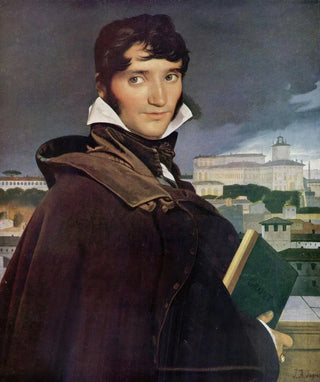Art print | Portrait of François Marius Granet 1777-1849 - Jean-Auguste-Dominique Ingres


View from behind

Frame (optional)
The "Portrait of François Marius Granet 1777-1849" by Jean Auguste Dominique Ingres is an iconic work that transcends a simple portrait to delve into the intimacy of a man, while revealing the technical mastery of its creator. Ingres, a major figure of neoclassicism, manages to capture the very essence of his subject, François Marius Granet, a renowned painter whose influence marked his era. This art print, faithful to the original, allows appreciation of the subtleties of composition and the depth of emotions emanating from this painting. In a world where art is often perceived as distant, this piece invites the viewer to an intimate dialogue with the past, through the penetrating gaze of the portrait.
Style and uniqueness of the work
Ingres's style is distinguished by a rigor and precision that give his portraits an almost sculptural dimension. In this work, every detail, from the rendering of clothing to facial expressions, is treated with remarkable meticulousness. The choice of colors, both sober and elegant, underscores the dignity of the depicted character. Granet's posture, slightly turned, creates a dynamic that engages the viewer, while maintaining a certain reserve. This duality between intimacy and distance is one of the major characteristics of Ingres's art, which succeeds in transcending a simple portrait to offer a true psychological study. Shadows and light, skillfully worked, add an extra depth, bringing the work to life and allowing the viewer to immerse themselves with fascination.
The artist and his influence
Jean Auguste Dominique Ingres, born in 1780, is often considered one of the greatest masters of neoclassicism. His career, marked by success, is characterized by an incessant quest for formal perfection. He managed to establish himself in an artistic context undergoing rapid change, where romanticism was beginning to emerge. Ingres, faithful to academic values, nevertheless knew how to incorporate elements of emotion and sensitivity into his works. His influence is palpable among many artists who followed, and his approach to portraiture paved the way for a new way of representing

Matte finish

View from behind

Frame (optional)
The "Portrait of François Marius Granet 1777-1849" by Jean Auguste Dominique Ingres is an iconic work that transcends a simple portrait to delve into the intimacy of a man, while revealing the technical mastery of its creator. Ingres, a major figure of neoclassicism, manages to capture the very essence of his subject, François Marius Granet, a renowned painter whose influence marked his era. This art print, faithful to the original, allows appreciation of the subtleties of composition and the depth of emotions emanating from this painting. In a world where art is often perceived as distant, this piece invites the viewer to an intimate dialogue with the past, through the penetrating gaze of the portrait.
Style and uniqueness of the work
Ingres's style is distinguished by a rigor and precision that give his portraits an almost sculptural dimension. In this work, every detail, from the rendering of clothing to facial expressions, is treated with remarkable meticulousness. The choice of colors, both sober and elegant, underscores the dignity of the depicted character. Granet's posture, slightly turned, creates a dynamic that engages the viewer, while maintaining a certain reserve. This duality between intimacy and distance is one of the major characteristics of Ingres's art, which succeeds in transcending a simple portrait to offer a true psychological study. Shadows and light, skillfully worked, add an extra depth, bringing the work to life and allowing the viewer to immerse themselves with fascination.
The artist and his influence
Jean Auguste Dominique Ingres, born in 1780, is often considered one of the greatest masters of neoclassicism. His career, marked by success, is characterized by an incessant quest for formal perfection. He managed to establish himself in an artistic context undergoing rapid change, where romanticism was beginning to emerge. Ingres, faithful to academic values, nevertheless knew how to incorporate elements of emotion and sensitivity into his works. His influence is palpable among many artists who followed, and his approach to portraiture paved the way for a new way of representing






